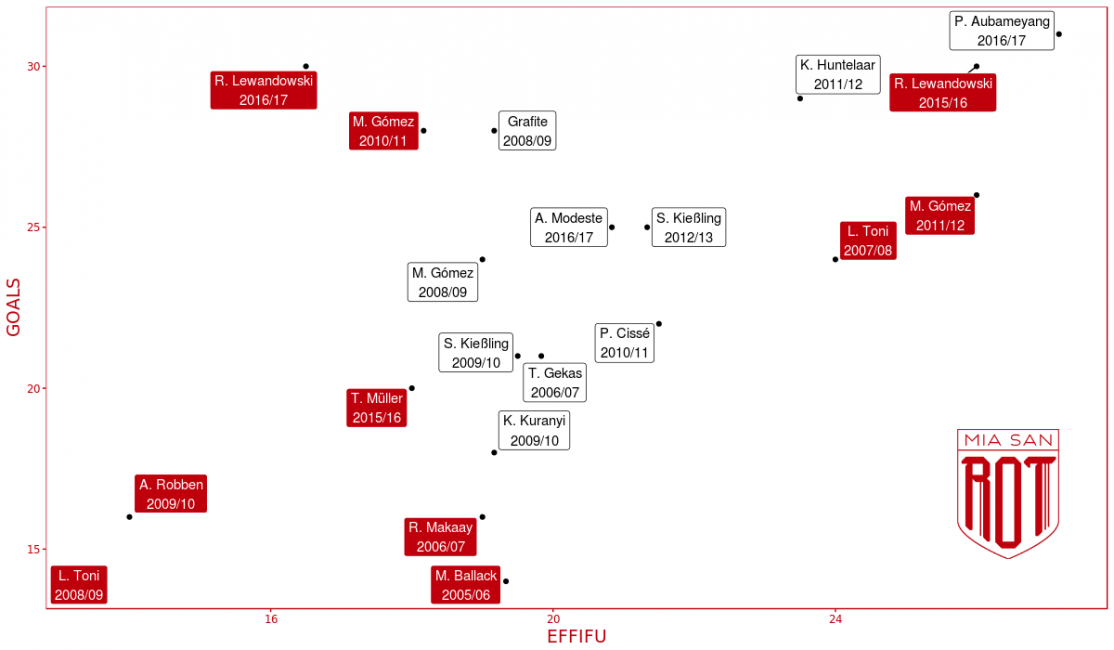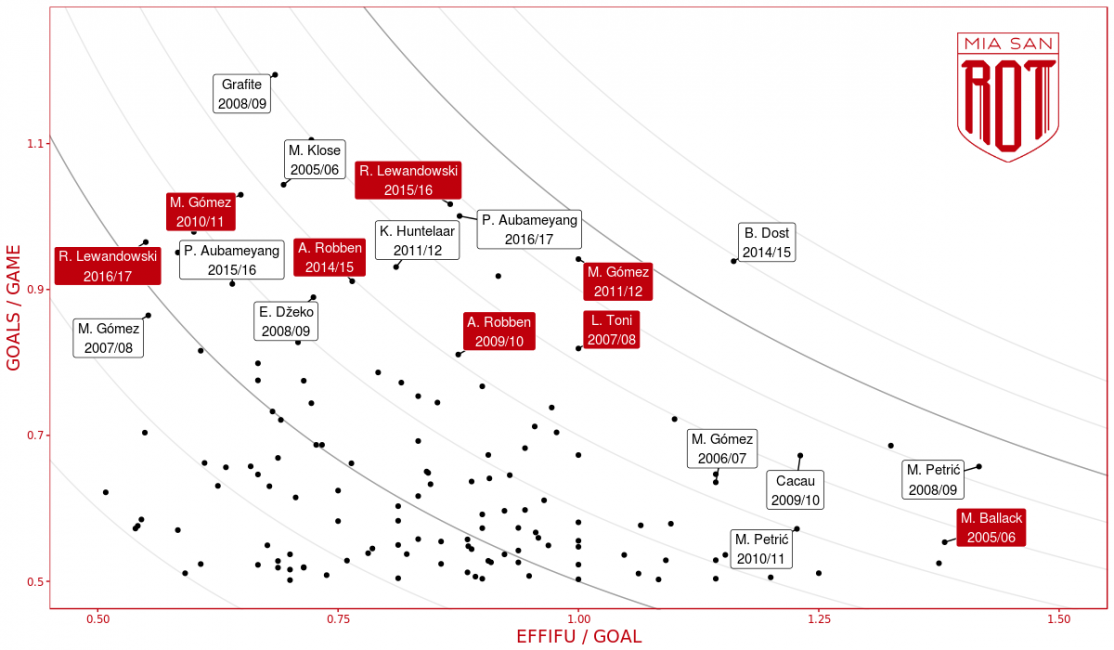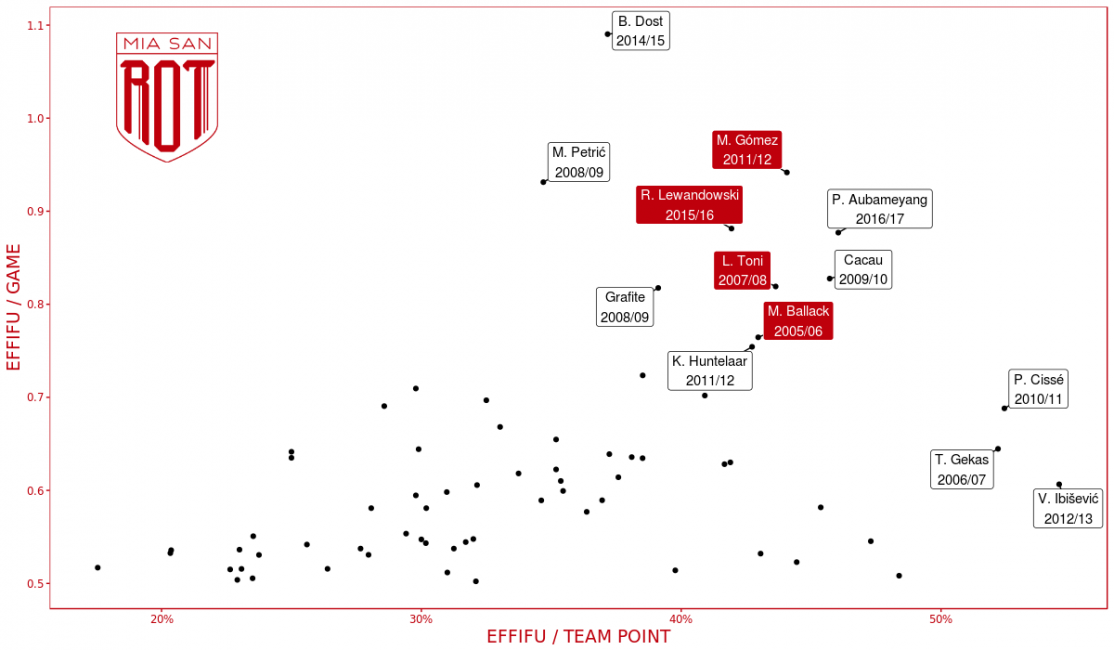Stats & Links: Where Dost puts Lewy in his place
What is EFFIFU?
EFFIFU, short for “efficient footballer” in German, was created by Sport Media Service GmbH. Between 1999/2000 and 2010/2011, the company also gave out an award to the player with the biggest impact on his team’s success.
There is a strict point system, which we will present shortly. For a 1-0 win, the sole goalscorer gets two points. However, a 2-1 win is weighted differently, with the first scorer receiving one point and the second one, two points. Goals scored for the losing side don’t count at all. A 1-1 draw results in one point per scorer, a 2-2 in 0.5 points each. More detailed information about EFFIFU can be found here.
To summarize, only decisive goals count for this stat. Miasanrot has taken a look at the vintage numbers from 2005 on forwards. In this edition of “Stats & Links”, we will present our results.
The best since 2005
Firstly, we will take a look at the most efficient players since 2005. The EFFIFU graphic shows the top ten Bayern players and the top ten of all other Bundesliga teams. You can see their total goals per respective season, as well.

(Visual: Lukas)
The best season was the one played by Dortmund Aubameyang last year, managing an EFFIFU of 27.16 for 31 scored goals. This surpassed Robert Lewandowski, who had been the previous record holder with 26 EFFIFU points for 30 goals in the season before that. He, in turn, had equaled Mario Gomez’ 2011/12 result.
Gomez, back in Stuttgart these days, appears three times in the Top 10 ranking, making it obvious that he’s good at scoring early or decisive goals for his teams.
One small surprise in the list is Michael Ballack, with the fourth-best Bayern season (2005/06), collecting 19.3 EFFIFU points for his 14 goals.
Dost in a league of his own
After pointing out the best and most efficient players, let’s take a closer look. The next graph ranks players by goals per game and EFFIFU points per goal. We added Isi lines to make readability easier.

(Visual: Lukas)
Analysing the vertical axis, goals per game, is fairly easy. But what does the x-axis show? EFFIFU points per scored goal show which players score important goals. The total amount of goals is less important here because of the added ratio.
A horizontal and vertical line split the graph into four areas. Area 1, bottom left, shows players who neither score much nor get important goals when they do. Please note that the graph is already skewed to show only players at the top of the Bundesliga. But we want to find the best of the best.
Area 2, top left, shows players who score loads but often only add insignificant goals to the scoreline. Drawing the vertical line at one EFFIFU point per goal, interestingly, makes both Lewandowski and Aubameyang drop into this category twice. Both become victims of the stat’s weakness in this; players who score many goals but also play for a team that scores many goals, can’t always be decisive, as there will be blowout results more frequently.
The third area, bottom right, shows players who don’t score as often, but whose goals are all the more important for that. Former HSV forward Mladen Petric appears double in this part, even achieving the all-time high EFFIFU per goal score in the 2008/09 season.
Like above, Michael Ballack is noticable here once more, scoring four times in tight 2-1 wins for Bayern in one season. He also secured a 1-1 draw in Hannover with a header on matchday 22.
Only three players make it into the fourth area, top right, where true A-list players show up. Gomez and Toni are both exactly on the border, but Bas Dost leaves everyone else in the dust behind him. In 2014/15, the Dutchman scored 16 goals and secured important points for his Wolfsburg team more than once, including a four-goal performance in their 5-4 win over Leverkusen.
Unusual deciders
Let’s also have a look at defensive players – are there any stand-outs who decide games despite their low position on the field?
A total of 227 players managed, since 2005, to collect more than 10 EFFIFU points over the course of one season; among them one defender and one defensive midfielder.
Central defender Maik Franz, an Eintracht Frankfurt player in the 2009/10 season, scored seven goals and achieved an EFFIFU of 10.5 – including his winning goals against Bochum and Leverkusen.
The only representative of the defensive midfielders is Simon Rolfes. The former German international scored eight times in 2007/08 for Leverkusen, earning him exactly 10 EFFIFU points.
Two more defenders deserve at least an honourable mention: Aytac Sulu (2015/16) and Daniel van Buyten (2009/10) both reached 9.5 EFFIFU points. Many Bayern fans will remember that Louis van Gaal often ordered the Belgian to play as a striker towards the end of a game to force a victory. Due to this move, he scored the winning goals in the closing minutes of the game against Nuremberg (matchday 5) and Frankfurt (matchday 10).
How important is EFFIFU?
Finally, we want to evaluate how important high-scoring EFFIFU players are for their teams. To do that, we look at the number EFFIFU points per game, in relation to the EFFIFU points per league table points at the end of a season.

(Visual: Lukas)
Yet again, Bas Dost leads the way in the EFFIFU / game stat, but other players we already mentioned, like Petric, Aubameyang, and Bayern’s strikers Gomez and Lewandowski make an appearance. All of them have a ratio higher than 30%.
There is one trio that bests everyone else: Gekas, Ibisevic, and Cisse have a ration of more than 50%, leaving them head and shoulders above everyone else. This means that their goals weren’t just important to win their teams points, but also that their teams would have been lost without them. Without each of these strikers and their important goals, their respective teams collected fewer points.
It’s hardly surprising, therefore, that all three also were their team’s most important players. Gekas (Bochum) and Cisse (Freiburg) even managed to carry their teams to single-digit league placements.
Links of the week
Top 100 Women’s Footballers of 2017 | 54: Mandy Islacker | The Offside Rule (Podcast)
National A-team minutes played in 2017, per employer club | Football Observatory
The Bandit | Javi Martínez
Cut in, shoot, repeat: Why Arjen Robben is a worthy Modern Great | Dan Clark | These Football Times
Player Analysis: David Alaba | Carlo Alessandro Valladares | ESDF Analysis
The Bayern blueprint: how Pep Guardiola moulded Manchester City’s unbeatables | Michael Butler | The Guardian
How Jupp Heynckes turned Bayern back into the machine we know | Andrew Thompson | Football Bloody Hell
The Throwback: Robert Lewandowski | Maciej Iwanski | The Blizzard
Bayer Leverkusen scout Laurent Busser makes Bayern Munich switch | Mark Lovell | ESPN FC
The Raumdeuter Role | Edgar Faroh | ESDF Analysis
Current Miasanrot-articles
The Alternative Awards 2017 | Felix
Youth Player of the Year: Oliver Batista Meier | Martin
3 Things: Leverkusen v Bayern 1-3 | Christopher
Rising Star of the Year 2017: Joshua Kimmich | Maurice
Player of the Year 2017: Mats Hummels | Justin
Current statistics and visualizations
You are currently viewing a placeholder content from X. To access the actual content, click the button below. Please note that doing so will share data with third-party providers.





